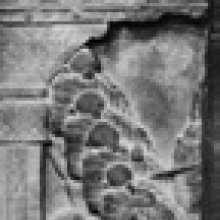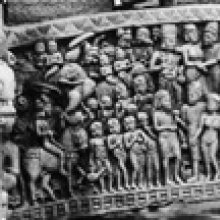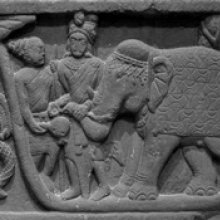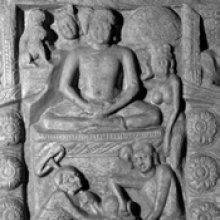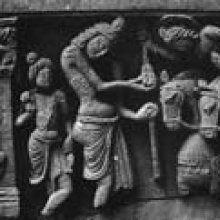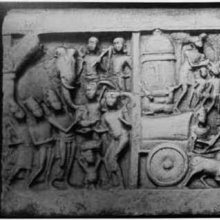Vessantara Jataka, Vessantara-jātaka: 1 definition
Introduction:
Vessantara Jataka means something in Buddhism, Pali. If you want to know the exact meaning, history, etymology or English translation of this term then check out the descriptions on this page. Add your comment or reference to a book if you want to contribute to this summary article.
Images (photo gallery)
(+2 more images available)
In Buddhism
Theravada (major branch of Buddhism)
Source: Pali Kanon: Pali Proper NamesVessantara (the Bodhisatta) was the son of Sanjaya, king of Sivi, and queen Phusati, and was so called because his mother started in labour as she passed through the vessa street in the city of Jetuttara, and he was born in a house in the same street. He spoke as soon as he was born (Cf. BuA.228). On the same day was also born a white elephant named Paccaya. At the age of eight, Vessantara wished to make a great gift and the earth trembled. He married Maddi at the age of sixteen, and their children were Jali and Kanhajina.
At that time there was a great drought in Kalinga, and eight brahmins came from there to Vessantara to beg his white elephant, which had the power of making rain to fall. He granted their request, and gave the elephant together with its priceless trappings (J.vi.488f. gives the details of these). The citizens of Jetuttara were greatly upset that their elephant should have been given away, and demanded of Sanjaya that Vessantara should be banished to Vankagiri. The will of the people prevailed, and Vessantara was asked to take the road along which those travel who have offended. He agreed to go, but before setting out, obtained the kings leave to hold an almsgiving called the Gift of the Seven Hundreds (Sattasataka), in which he gave away seven hundred of each kind of thing. People came from all over Jambudipa to accept his gifts, and the almsgiving lasted for a whole day.
When Vessantara took leave of his parents and prepared for his journey, Maddi insisted on accompanying him with her two children. They were conveyed in a gorgeous carriage drawn by four horses, but, outside the city, Vessantara met four brahmins who begged his horses. Four devas then drew the chariot, but another brahmin soon appeared and obtained the chariot. Thenceforward they travelled on foot, through Suvannagiritala, across the river Kantimara, to beyond Mount Aranjaragiri and Dunnivittha, to his uncles city, in the kingdom of Ceta. The devas shortened the way for them, and the trees lowered their fruit that they might eat. Sixty thousand khattiyas came out to welcome Vessantara and offered him their kingdom, which, however, he refused. He would not even enter the city, but remained outside the gates, and, when he left early the next morning, the people of Ceta, led by Cetaputta, went with him for fifteen leagues, till they came to the entrance to the forest. Vessantara and his family then proceeded to Gandhamadana, northwards, by the foot of Mount Vipula to the river Ketumati, where a forester entertained them and gave them to eat. Thence they crossed the river to beyond Nalika, along the bank of Lake Mucalinda, to its north eastern corner, then along a narrow footpath into the dense forest, to Vankagiri. There Vissakamma had already built two hermitages, by order of Sakka, one for Vessantara and one for Maddi and the children,
Theravāda is a major branch of Buddhism having the the Pali canon (tipitaka) as their canonical literature, which includes the vinaya-pitaka (monastic rules), the sutta-pitaka (Buddhist sermons) and the abhidhamma-pitaka (philosophy and psychology).
See also (Relevant definitions)
Partial matches: Vessantara, Jataka.
Ends with: Mahavessantara Jataka.
Full-text (+6): Maharajapabba, Kumarapabba, Cullavanavannana, Danakkhanda, Vessantara, Sakkapabba, Maddipabba, Jetuttara, Chakkhattiyakhanda, Dunnivittha, Vanappavesanakhanda, Pamsukuladhovana Jataka, Dasavaragatha, Ketumati, Aritthapura, Jali, Sivirattha, Maddi, Cinca Manavika, Sanjaya.
Relevant text
Search found 14 books and stories containing Vessantara Jataka, Vessantara-jātaka; (plurals include: Vessantara Jatakas, jātakas). You can also click to the full overview containing English textual excerpts. Below are direct links for the most relevant articles:
Amaravati Art in the Context of Andhra Archaeology (by Sreyashi Ray chowdhuri)
Vessantara Jātaka < [Chapter 3 - Amarāvatī and the Formative Stage of the Buddhist Art]
Lower Kṛṣṇā Valley (6): Goli < [Chapter 2 - Amarāvatī and other Archaeological Sites of Ancient Andhra Pradesh]
Bandhuma Jātaka < [Chapter 3 - Amarāvatī and the Formative Stage of the Buddhist Art]
Maha Prajnaparamita Sastra (by Gelongma Karma Migme Chödrön)
Part 6 - Viśvantara-Jātaka (or Vessantara-jātaka) < [Chapter XX - The Virtue of Generosity and Generosity of the Dharma]
The Viśvantara-jātaka < [I. Puṇyakriyāvastu consisting of generosity]
A Heart Released (by Phra Ajaan Mun Bhuridatta Thera)
Dhammapada (Illustrated) (by Ven. Weagoda Sarada Maha Thero)
Verse 168-169 - The Story of King Suddhodana < [Chapter 13 - Loka Vagga (World)]
Verse 13-14 - The Story of Monk Nanda < [Chapter 1 - Yamaka Vagga (Twin Verses)]
Jainism in Odisha (Orissa) (by Ashis Ranjan Sahoo)
Jain Iconography in Odisha (Introduction) < [Chapter 6]
Dipavamsa (study) (by Sibani Barman)
